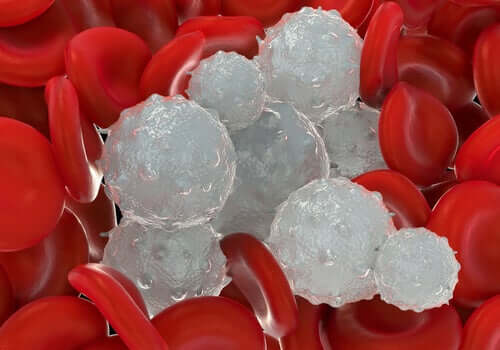Everything You Need to Know about Hematologic Diseases


Written and verified by the doctor Leonardo Biolatto
There are many different hematologic diseases. Some are relatively common, while others are very rare. A type of abnormality in the production of blood or some of its components cause them.
Most of them can appear at any age, and almost all of them can lead to serious health problems if left untreated. Below, you’ll discover the main hematologic diseases, according to the most conventional classification.
Anemias
This is one of the most common hematologic diseases. However, we should actually refer to them as anemias, as there are several types. They’re all characterized by low hemoglobin levels.
The main types of anemia are:
- Iron deficiency. It’s a type of anemia that occurs due to iron deficiency, which the body needs to produce hemoglobin. It’s the most common type.
- Megaloblastic. Also known as “vitamin deficiency anemia”. It’s a disease that’s characterized by deformed or enlarged red blood cells. Low levels of some vitamins causes it.
- Hemolytic. It’s a group of disorders in which red blood cells are destroyed faster than they’re produced.
- Aplastic. This is a rare hematologic disease, in which the body isn’t able to produce all the red blood cells the body needs in the bone marrow.
- Fanconi anemia. This is a rare hereditary disease characterized by bone marrow failure, congenital malformations, and a tendency to develop solid or blood tumors.

Leukemia, one of the most serious hematologic diseases
Leukemia is one of the most serious hematologic diseases, as it’s a type of blood cancer. It appears in the bone marrow and causes a rapid growth of abnormal white blood cells. Cancer cells impair the production of red blood cells, platelets, and also white blood cells.
The main types of leukemia are:
- Acute lymphocytic leukemia (ALL). This type of leukemia progresses quickly and is characterized by the proliferation of a type of white blood cell called lymphocytes or lymphoblasts. It’s also the most common type in children.
- Acute myelogenous leukemia (AML), which is a rapidly progressive leukemia that affects myeloid cells. This is a type of white blood cell which normally develops into various types of mature white blood cells, red blood cells, or platelets.
- Chronic lymphocytic leukemia (CLL). It’s basically the same as acute lymphocytic leukemia but it progresses slowly. It’s more common in older adults.
- Chronic myelogenous leukemia (CML). Although it’s similar to acute myelogenous leukemia, it progresses slowly. This is the type of leukemia with the best prognosis.
- Hairy cell leukemia. This type is characterized by an excessive production of B cells, which “look hairy” under a microscope.
Keep reading to learn more: Scientists Discover Way To Make Leukemia Cells Destroy Themselves
Lymphomas
Lymphomas are a type of cancer in which there’s an indiscriminate proliferation of lymphocytes. In other words, they increase the immune system’s defense cells. It also arises if the lymphocytes don’t die when they should. Although this usually occurs in the lymph nodes, it can also occur in the liver or spleen.
There are more than 60 varieties of this type of hematologic disease. However, for practical purposes, they’ve been mainly classified into two groups:
- Firstly, Hodgkin lymphoma. A lymphatic system cancer in which there’s an abnormal growth and spread of cells. It accounts for 22% of total lymphoma cases and is more common in people 20 to 40 years old.
- Secondly, non-Hodgkin lymphoma. This is a lymphatic cancer in which tumors form from lymphocytes, a type of white blood cell. It’s the most common type of lymphoma.
Multiple myeloma
This is a type of lymphatic system tumor that’s characterized by the proliferation of plasma cells. These cells produce the antibodies that protect the body from infections and foreign bodies.
Plasma cells are found in the bone marrow. They should multiply to fight a foreign agent. When it disappears, the proliferation ceases. Myeloma causes the cells to continue to grow and accumulate, excessively producing the same antibody.
Myeloma can be symptomatic or asymptomatic. Although it mainly affects older adults, it can appear from the age of 40. Experts don’t yet know what causes it.

Find out more here: What Is Multiple Myeloma?
Other hematologic diseases
We should also mention other hematologic diseases with a lower prevalence than the ones we just explained above:
- Hemochromatosis or iron overload. An excessive absorption of iron that leads to several serious diseases.
- Prothrombic coagulation disorders. A platelet disorder that causes excessive clotting.
- Bleeding disorders. Coagulation abnormalities that lead to continuous bleeding.
- Chronic myeloproliferative syndromes. A group of several diseases characterized by an uncontrolled production of bone marrow cells.
- Myelodysplastic syndromes. A group of cancers in which bone marrow blood cells don’t mature or don’t produce healthy blood cells.
- Porphyrias. A group of diseases characterized by an accumulation of various substances that produce porphyrin.
How to detect a hematologic disease
Hematologic diseases are detectable. Thus, you should go see your doctor if you have any suspicious symptoms or a family history of these diseases. It’s also essential for children and adults to get routine check-ups, as this helps ensure early detection.
All cited sources were thoroughly reviewed by our team to ensure their quality, reliability, currency, and validity. The bibliography of this article was considered reliable and of academic or scientific accuracy.
- Sosa, H., Fernández-Calleja, V., Hernández, P., Schvartzman, J. B. S., Krimer, D. B., & Fernández-Nestosa, M. J. (2019). Análisis de líneas celulares eritroleucémicas con deleciones de genes implicados en el desarrollo de enfermedades hematológicas severas. Revista Científica Estudios e Investigaciones, 8, 19-20.
- Xu, Weixian, Tracy Y. Wang, and Richard C. Becker. “Enfermedades hematológicas: desde dentro del corazón.” Revista espanola de cardiologia 64.7 (2011): 606-613.
- Rojas, Alicia, et al. “Anomalías cromosómicas en enfermedades hematológicas malignas.” Acta Científica Venezolana 51.2 (2000): 109-114.
- Pérez, J., J. C. Gómez, and D. Almaguer. “La sangre y sus enfermedades.” Hematología 3 (2016): 118-128.
- Medina Córdoba, Camila Alejandra, and Marjorie Pérez Villa. “Medidas no farmacológicas implementadas por las enfermeras para el dolor de niños con Leucemia Linfocítica Aguda.” Index de Enfermería 28.1-2 (2019): 46-50.
This text is provided for informational purposes only and does not replace consultation with a professional. If in doubt, consult your specialist.








